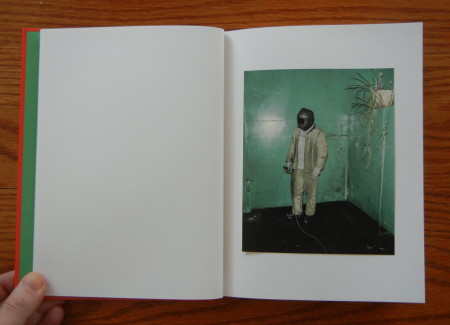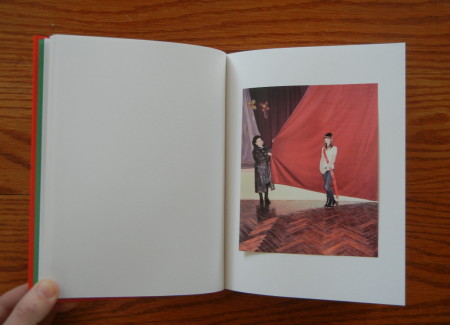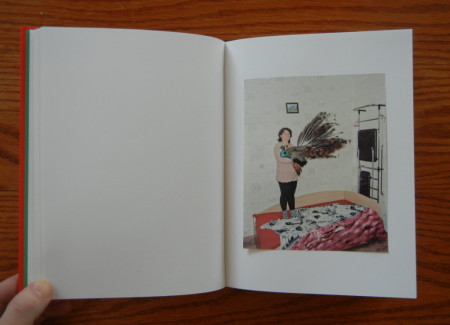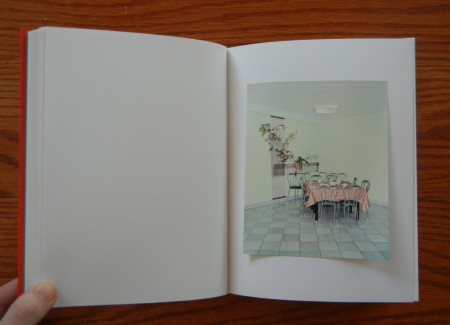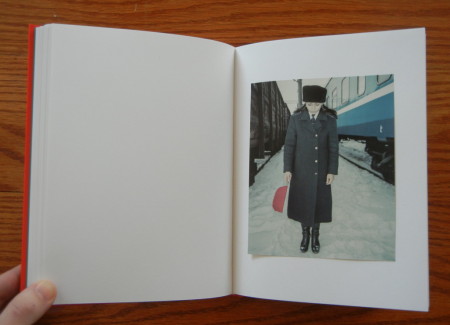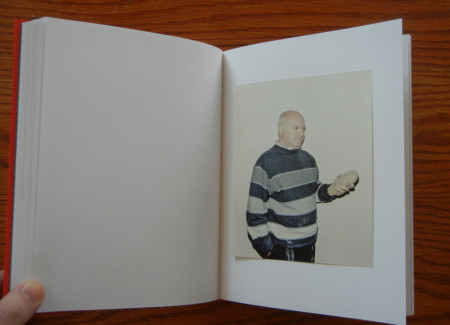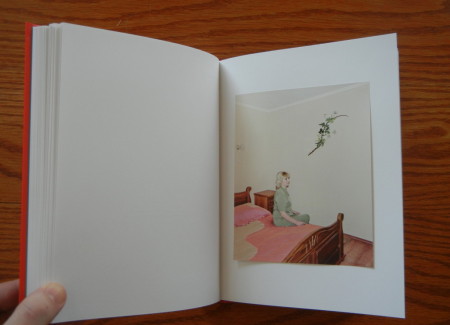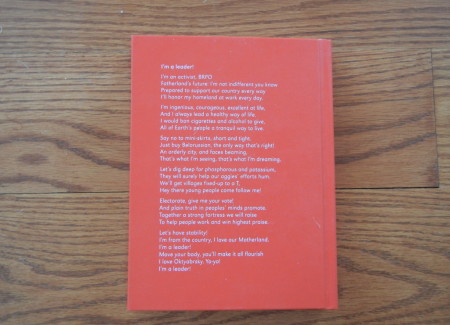JTF (just the facts): Published in 2014 by GOST Books (here). Hardcover, 112 pages, with 53 color photographs. The photographs are affixed only on the top, with text captions printed underneath the images. There are no texts or essays, aside from a Presidential decree on the front cover, and song lyrics on the back cover. In a Special Edition of the book, one of the images has been omitted from each book, and replaced by an original print which has been attached in its place. The Winners was shortlisted for the 2014 Paris Photo–Aperture Foundation Photobook of the Year award. (Spread shots below.)
Comments/Context: In countries where the state keeps the press under tight control, it isn’t easy for artists and photojournalists to tell the stories they want to tell. Instead of having the freedom to wander and investigate the perhaps less positive aspects of a society that they might find worth exploring and understanding, they are often toured around (under strict travel restrictions) to visit model factories and dull villages, kept on a short leash, and generally shown only the patriotic perfection the authorities want them to see. When image restrictions are placed on top of these working impediments, the result is an indirect kind of propaganda, where the inflexible limitations on subject matter and destination inevitably lead to a third party version of the controlled message the state wants to put out.
Press restrictions are unfortunately commonplace in today’s Belarus, so Polish photographer Rafal Milach designed a project that would both satisfy the demands of the authorities and allow him to express his own point of view. Milach traveled to cities and towns all over the country and photographed the various winners of state and local competitions sponsored by the Belarusian government. These contests often promoted beauty or public space maintenance, awarding prizes to model citizens and companies. And while The Winners does indeed document these “success stories”, it does so with a level of visual and conceptual sophistication that undermines the whole endeavor. Milach patiently follows all the rules, and still finds away to be subtly subversive; his results are simultaneously deadpan serious, genuinely celebratory, quietly ridiculous, and more than a little depressing.
The images in the book are mostly in situ portraits of winners of various contests, generally standing in their usual environments (often with a sash or trophy), along with a few still lifes and interiors that document “best of” places and things. While many of the categories tend toward the mundane (best teacher, policeman, truck driver, student, tax inspector, beauty contest winner etc.), it’s the more eccentric categories that give the book its quirky flavor. How can we not be enchanted by the best milkmaid, the best Vital Records employee, the best Jennifer Lopez lookalike, or the most beautiful staircase in Minsk? The book unfolds like a parade of unlikely heroes – the lumberjack, the hunter, the National Library worker, the couple in love, the hotel maid, the potato company president, and the street maintenance worker. We puzzle over the best daily cattle weight gain, the best ploughman (who refused to be photographed), a pile of the best starch, and the best large family.
What makes Milach’s compendium so compelling is that the entire mood of the series is slightly off. His photographs blast his subjects with a harsh flash, washing them out and leaving many frozen with blank stares; in general, these aren’t smiling happy winners. Nondescript backgrounds are exposed as dreary hallways or offices, with curtains pulled over as makeshift fancy backdrops. The best ideology room is empty save a political poster, a blank white board, and some sad potted plants; the best public canteen has dust in the corners and a strangely surreal fish statue as decoration. And Miss Belarusian Railways, Mister Gay Belarus, and Miss Bust look somewhat less than completely proud of their award winning performances. Seen together, there is a sense of the entire country obligingly going through the motions, the pictures showing us a photo-op sham that everyone is wearily playing along with. At first glance, Milach’s vision might appear to be a kind of easy post-Soviet mockery, but as the pages turn and the pictures pile up, the façade crumbles and we’re left with something more quietly bleak.
Construction-wise, Milach’s photobook is sneakily ambitious. At first glance, it looks entirely straightforward – color reproductions, all the same size, centered on white backgrounds, on right hand pages. What could be more conventional? But after a few page flips, something weird starts to happen – the images seem like they are coming unglued, flapping away from the pages like loose inserts, almost as if the adhesive is faulty or it’s a shoddy manufacturing job. What then becomes clear is that the thin pictures are glued only along their top edges, and when they are raised up, explanatory text captions are discovered underneath (see detail image above). It is this text that explains that a young woman holding a laptop in a bare room is actually the winner of the best patriotic computer game award, for without these hidden clues, we would be hard pressed to identify what exactly many of these people were actually singled out for. The front/behind arrangement of the image/text, the illicitness of the page lifting, and the absurdity of what we often find underneath all smartly reinforce Milach’s larger messages.
It’s this shifting duality between toeing the line and pulling back the curtain that gives Milach’s project its vitality. I expected this book to be jokily clever, and on the surface, I suppose that’s what many will see. But I think Milach also pushes quite hard on the uneasy nature of propaganda, and on the everyday complexities that those living under a regime of controlled information have to deal with. Milach’s winners are all dutifully playing their parts, but no one is convinced that these adulations are anything more than window dressing. His photobook is tragedy dressed as comedy, and it’s surprisingly biting.
Collector’s POV: Rafal Milach is represented by Institute (here). His work has little secondary market history at this point, so gallery retail or connecting directly with the artist via his website (linked above) will be the best options for those collectors interested in following up.


